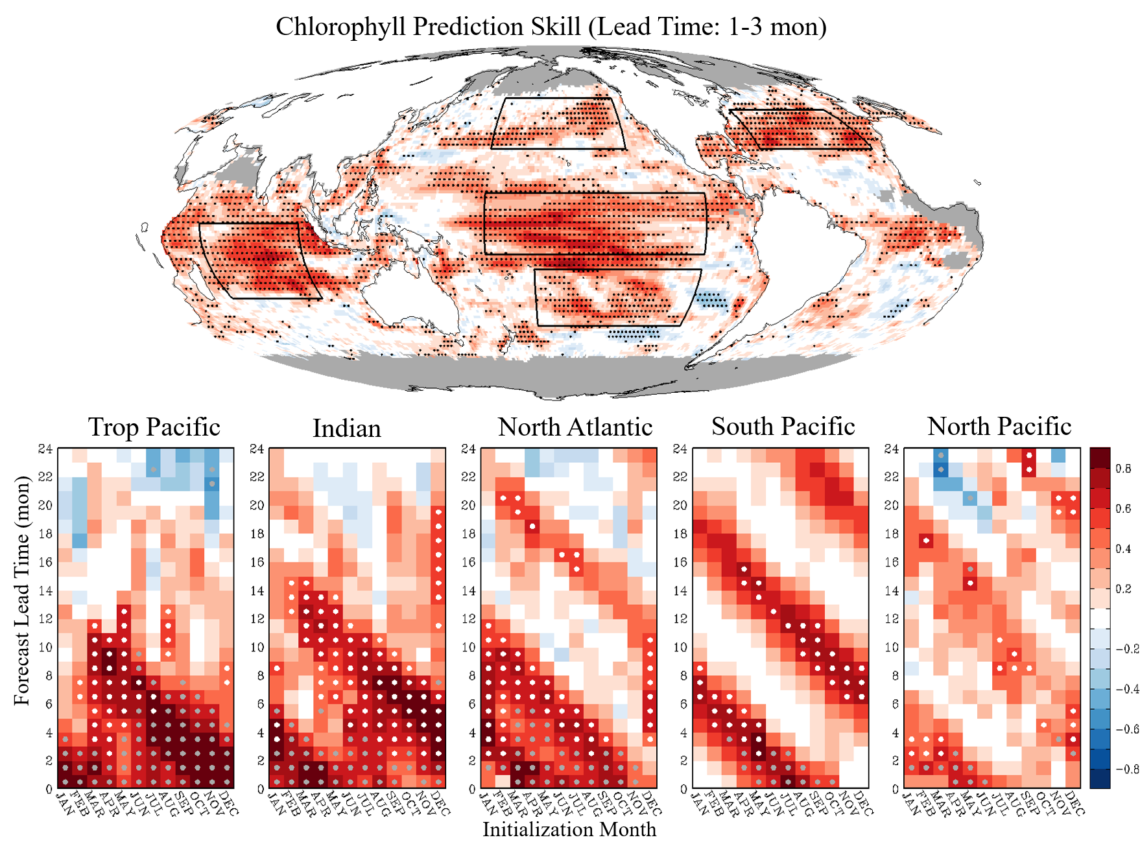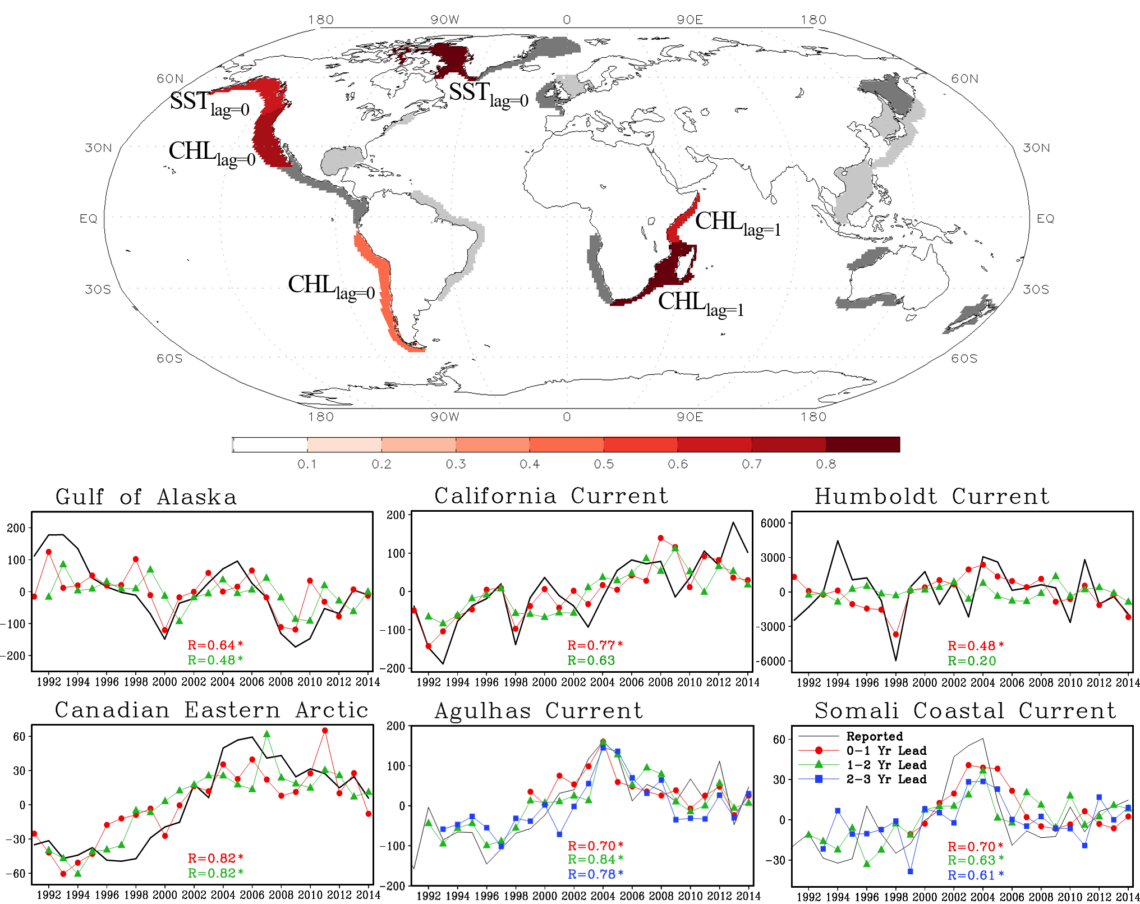July 18th, 2019
Key Findings
- Newly developed ESM-based marine biogeochemical predictions can skillfully predict seasonal to multi-annual chlorophyll fluctuations in many ocean regions.
- This research indicates that annual fish catches in selected large marine ecosystems can be predicted from chlorophyll and sea surface temperature anomalies up to 2-3 years in advance.
- The prediction system is constructed by integrating GFDL’s COBALT marine biogeochemical model with seasonal to multi-annual climate predictions from GFDL’s CM2.1 climate model.
- Biogeochemical prediction systems can extend beyond sea surface temperature and chlorophyll to include other potential drivers, including oxygen, acidity, net primary production, and zooplankton.
Jong-Yeon Park, Charles A. Stock, John P. Dunne, Xiaosong Yang, Anthony Rosati. Science. DOI: 10.1126/science.aav6634
Climate variations profoundly impact marine ecosystems and the communities that depend upon them. Anticipating these shifts using global Earth System Models (ESMs) could enable communities to adapt to climate fluctuations and contribute to long-term ecosystem resilience. The authors show that newly developed ESM-based marine biogeochemical predictions can skillfully predict observed seasonal to multi-annual chlorophyll fluctuations in many regions. The authors also provide an initial assessment of the potential utility of such predictions for marine resource management.
Chlorophyll prediction skill arises primarily from successfully simulating the chlorophyll response to the El-Niño Southern Oscillation (ENSO) and capturing the extra-tropical winter re-emergence of subsurface nutrient anomalies that affect chlorophyll levels during the productive spring, summer and fall seasons. This research also indicates that annual fish catches in selected large marine ecosystems can be predicted from chlorophyll and sea surface temperature forecasts, in some cases up to 2-3 years in advance. This, together with high predictability for other marine-resource relevant biogeochemical properties, suggests a role for ESM-based marine biogeochemical predictions in dynamic marine resource management efforts.
The incorporation of biogeochemical processes into global climate models has transformed them into ESMs that represent the interacting physical, chemical, and biological processes shaping global carbon and nutrient cycles. For oceans, ESMs have provided outlooks for marine changes beyond warming, including ocean acidification, deoxygenation, and changing ocean productivity. While the reliability of physical predictors alone for anticipating marine ecosystem responses is often limited, recent observations and modeling studies suggest that biogeochemical drivers (e.g., acidity, oxygen, primary production) may be more predictable and have strong linkages to marine resource responses.
This study presents results from global biogeochemical forecasts initialized on the first of each month between 1991 and 2017. Each prediction has 12 ensemble members, creating a database of nearly 4000 forecasts and 8000 simulation years. The prediction system is constructed by integrating the Carbon, Ocean Biogeochemistry and Lower Trophics (COBALT) marine biogeochemical model with seasonal to multi-annual climate predictions from the Geophysical Fluid Dynamics Laboratory’s CM2.1 climate model and multi-annual climate prediction system.
Predictions are assessed against 30 years of satellite-derived chlorophyll estimates, which offer a near-global, continuous, multi-decade time series of ocean ecosystem anomalies. Chlorophyll has also been found to be a robust indicator of cross-ecosystem and, in some places, inter-annual fish catch variations.
The global marine biogeochemical prediction system produces skillful chlorophyll predictions one season in advance in many ocean regions and extends beyond 1 year in some regions. In the tropical Pacific, prediction skill is limited to maximum leads of 12 months, with peak skill for fall/winter forecasts and reduced skill for boreal spring predictions. Strong negative/positive winter chlorophyll anomalies are tightly linked to El-Niño/La-Niña events. In the subtropical to temperate North Atlantic, chlorophyll anomalies are not predictable in winter, but are predictable during the productive spring, summer and fall (i.e., the growing season). Furthermore, prediction skill remains evident through two growing seasons with leads up to 24 months.
Biogeochemical prediction systems can extend beyond sea surface temperature and chlorophyll to include other potential drivers, including oxygen, acidity, net primary production, and zooplankton. Assessment of net primary production predictions against satellite-based algorithms suggest similar patterns of predictability as chlorophyll, while model-based assessments of the potential predictability of other drivers suggests that they may be more predictable than chlorophyll or sea surface temperature.




